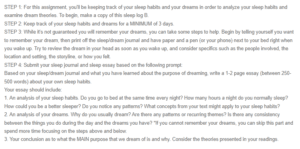Sleep and Dream Journal
I tracked my sleep habits and dream patterns for three days to obtain a better grasp of my own sleep practices. My sleep patterns are not constant; I frequently go to bed at different times each night, influenced by various variables such as work deadlines or personal preference. I sleep about 6-7 hours per night on average. To improve my sleep, I should focus on developing a consistent sleep routine, ensuring that I go to bed and wake up at the same time every day. Variations in sleep duration, the incidence of vivid dreams on some nights, and the absence of dreams on others were among the patterns I saw during the three-day period. Several concepts can be used to theoretically assess my sleeping habits. The concept of circadian rhythms, which regulate our sleep-wake cycle, emphasizes the significance of having a constant bedtime in order to sync with our internal body clock.
Analyzing my dreams reveals that they frequently function as a reflection of my daily events and subconscious thinking. My dreams frequently appear to result from the events, feelings, or pressures I experience during the day, implying that they may serve as a form of processing and organizing these experiences. While there were no regular recurrent themes over this three-day period, there was a notable association between my day’s activities and emotions and the substance of my dreams.
The major purpose of dreaming is still being debated and explored, with numerous hypotheses proposed in the field of psychology. One widely held belief is that dreams serve as a method for digesting and consolidating daily experiences and emotions, assisting people in making sense of their waking lives. Dreams, according to Freudian beliefs, are an outlet for repressed urges and unresolved conflicts, whereas newer views, such as the activation-synthesis model, indicate that dreams are the brain’s attempt to make sense of random neuronal activity during sleep (Wamsley & Stickgold, 2010).
References
Wamsley, E. J., & Stickgold, R. (2010). Dreaming and offline memory processing. Current Biology, 20(23). https://doi.org/10.1016/j.cub.2010.10.045
ORDER A PLAGIARISM-FREE PAPER HERE
We’ll write everything from scratch
Question

Sleep and Dream Journal
STEP 1: For this assignment, you’ll be keeping track of your sleep habits and your dreams in order to analyze your sleep habits and examine dream theories. To begin, make a copy of this sleep log B.
STEP 2: Keep track of your sleep habits and dreams for a MINIMUM of 3 days.
STEP 3: While it’s not guaranteed you will remember your dreams, you can take some steps to help. Begin by telling yourself you want to remember your dream, then print off the sleep/dream journal and have paper and a pen (or your phone) next to your bed right when you wake up. Try to review the dream in your head as soon as you wake up, and consider specifics such as the people involved, the location and setting, the storyline, or how you felt.
STEP 4: Submit your sleep journal and sleep essay based on the following prompt:
Based on your sleep/dream journal and what you have learned about the purpose of dreaming, write a 1-2 page essay (between 250-500 words) about your own sleep habits.
Your essay should include:
1. An analysis of your sleep habits. Do you go to bed at the same time every night? How many hours a night do you normally sleep? How could you be a better sleeper? Do you notice any patterns? What concepts from your text might apply to your sleep habits?
2. An analysis of your dreams. Why do you usually dream? Are there any patterns or recurring themes? Is there any consistency between the things you do during the day and the dreams you have? *If you cannot remember your dreams, you can skip this part and spend more time focusing on the steps above and below.
3. Your conclusion as to what the MAIN purpose that we dream of is and why. Consider the theories presented in your readings.

